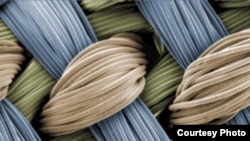For millions of people around the world, arthritis is an unfortunate - and painful - part of getting older. As the condition progresses, it can require surgery to replace with plastic or metal hardware the worn cartilage that no longer cushions the joint. But these artificial joints are not ideal, so researchers using innovative technologies are working to create an artificial cartilage that’s more like the real thing.
Arthritis is a very painful condition. The operation to treat it is not much better. Anybody who has had a knee, shoulder or hip joint replaced knows that artificial metal or plastic joints also can be painful and limit movement. But coming up with a better alternative for eroded cartilage - a substitute that’s both load-bearing and cushioning at the same time - has been a challenge.
Farshid Guilak, professor of mechanical engineering and orthopedic surgery at Duke University in North Carolina, is part of a team working to create a strong yet softer, more supple replacement for worn away cartilage. He foresees that implanting this synthetic cartilage would be a much less radical operation than current joint surgery.
“So, just basically replacing the part that is worn out, not cutting out both sides of the joint and putting a lot of metal in there," said Guilak.
At the heart of the synthetic cartilage is an innovative fabric scaffold, which Guilak and colleagues at Duke developed in collaboration with researchers at Harvard University in Massachusetts. The novel material is made of seven layers of miniscule interwoven fibers, each about as thick as a human hair. A water-based gel is infused into the scaffolding, making it strong, flexible and lubricated.
Then, the patient’s stem cells would be injected into the fabric. Guilak says they could grow between the layers into a living cartilage one millimeter thick that is customized to the patient’s diseased joints.
“I think what we will be able to do if this succeeds is just remove the worn out cartilage and basically cap it with this material, which would just replace the cartilage itself and leave all the native bone in place. So it’s a much less invasive surgery and hopefully replace it with a living cartilage," he said.
Guilak and colleagues are now planning animal experiments with the synthetic cartilage.
An article on the development is published in the journal Advanced Functional Materials.
Arthritis is a very painful condition. The operation to treat it is not much better. Anybody who has had a knee, shoulder or hip joint replaced knows that artificial metal or plastic joints also can be painful and limit movement. But coming up with a better alternative for eroded cartilage - a substitute that’s both load-bearing and cushioning at the same time - has been a challenge.
Farshid Guilak, professor of mechanical engineering and orthopedic surgery at Duke University in North Carolina, is part of a team working to create a strong yet softer, more supple replacement for worn away cartilage. He foresees that implanting this synthetic cartilage would be a much less radical operation than current joint surgery.
“So, just basically replacing the part that is worn out, not cutting out both sides of the joint and putting a lot of metal in there," said Guilak.
At the heart of the synthetic cartilage is an innovative fabric scaffold, which Guilak and colleagues at Duke developed in collaboration with researchers at Harvard University in Massachusetts. The novel material is made of seven layers of miniscule interwoven fibers, each about as thick as a human hair. A water-based gel is infused into the scaffolding, making it strong, flexible and lubricated.
Then, the patient’s stem cells would be injected into the fabric. Guilak says they could grow between the layers into a living cartilage one millimeter thick that is customized to the patient’s diseased joints.
“I think what we will be able to do if this succeeds is just remove the worn out cartilage and basically cap it with this material, which would just replace the cartilage itself and leave all the native bone in place. So it’s a much less invasive surgery and hopefully replace it with a living cartilage," he said.
Guilak and colleagues are now planning animal experiments with the synthetic cartilage.
An article on the development is published in the journal Advanced Functional Materials.




